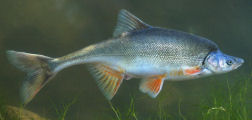The population of humpback chub, a fish found only in the Colorado River and its tributaries, may be stabilizing in sections of the Grand Canyon, new data suggest.

Gila cypha, a member of the minnow family that can grow to 50 centimeters in length, was declared endangered in 1967. The species suffered from the ecological effects of the Glen Canyon Dam, including cooler-than-normal water temperatures, and predation by nonnative fish such as trout (SN: 3/5/05, p. 152: Available to subscribers at Straight Flush). In the 1990s, up to 20 percent of adult chub were dying each year, and young fish weren’t surviving in numbers sufficient to replace those losses, says Matthew Andersen, a biologist with the U.S. Geological Survey in Flagstaff, Ariz.
However, 2005 surveys in the Grand Canyon found more hatchlings and more juveniles up to age 4 years than had been tallied during recent years. Between 2001 and 2005, the population of older humpback chub appears to have held steady at about 5,000, the agency announced Aug. 3.
Several factors may have stemmed the chub’s decline, says Andersen. Since 2003, researchers have removed about 60 percent of the rainbow trout and brown trout, which prey on young chub, from the species’ main spawning grounds. Also, an extended drought in the Southwest has caused summertime water temperatures near those spawning grounds to exceed 17°C—the minimum temperature needed for chub to reproduce in large numbers—for the first time since 1980.






